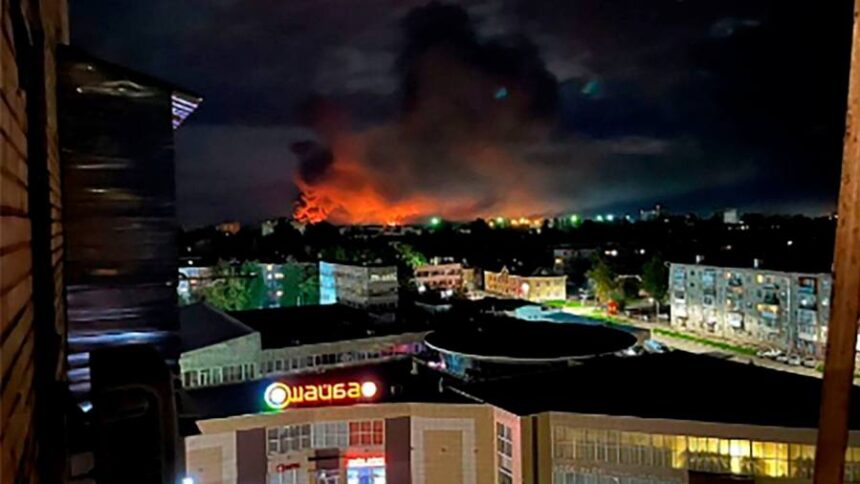Receive free War in Ukraine updates
We’ll send you a myFT Daily Digest email rounding up the latest War in Ukraine news every morning.
Drones struck an airport in the Pskov region of Russia overnight, destroying several military cargo planes, in the most sweeping unmanned aerial assault by Ukraine inside enemy territory in 18 months of war.
Videos showed blasts of rocket fire over the city of Pskov overnight as Russian air defences attempted to take down the drones, with flames rising over the city’s military-civilian airport.
According to state news agency Tass, at least four Ilyushin Il-76 planes, large military cargo carriers, were destroyed in the attack.
Drones also attacked targets in the Oryol, Kaluga and Ryazan regions, and in Bryansk, where they aimed for the local television tower, among other buildings. Another drone aiming for Moscow was shot down in the Ruzsky district west of the city, the Russian defence ministry claimed.
The airport in Pskov was closed to civilian use on Wednesday, Russia’s aviation agency said. The governor said authorities needed to assess whether there had been any damage to its landing strip.
Emergency services told the Tass state news agency that four Il-76 planes were damaged. “A fire started, two aircraft are engulfed in flames,” it said.
Ukraine has steadily extended its ability to strike targets deeper behind enemy lines. It has used foreign-supplied artillery and missile systems, such as US Himars and British Storm shadow missiles, to hit Russian targets on Ukrainian soil.
But to strike within Russian territory, Ukraine has had to develop homegrown solutions as its western allies have refused to give it weapons to attack Russia itself.
Such attacks “have military utility”, Mick Ryan, a former Australian general and frequent commentator on the war in Ukraine, said on social media, because they “could force redeployment of Russian air force assets from Ukraine”.
Since Ukrainian drones fly more slowly and at a lower altitude than missiles, and are often made of non-metallic parts, analysts say they have sometimes been able to dodge Russian air defences.
Meanwhile, Ukraine’s improved air defences have been increasingly able to intercept Russian aerial attacks. Russia launched a massive missile and drone attack on Kyiv overnight that left at least two dead and two wounded. But Ukrainian air defences managed to down all 28 missiles and 15 out of the 16 Russian drones, according to Valery Zaluzhny, commander-in-chief of Ukraine’s armed forces.
Moscow’s three main airports were also briefly closed to flights overnight, leading a dozen passenger flights to be redirected to other airports. The three airports have now been reopened.
“Tonight there was an attempted mass drone attack across the Central Federal District,” Moscow mayor Sergei Sobyanin said, using the administrative term for the central region of Russia. “One of the UAVs heading towards Moscow was destroyed by air defence forces in the Ruzsky district.”
Alexander Bogomaz, the governor of the Bryansk region that borders Ukraine, reported drone attacks three times on his social media channel over the course of the night and the morning, claiming each was impeded by air defences and caused only minor damage.
“Two drones tried to attack the TV tower,” he wrote on Wednesday morning. “There were no casualties or damage. The fire at the site of the downed drones has been extinguished. Operational and emergency services are working at the site.”
In Crimea, the Black Sea peninsula that Russia annexed from Ukraine in 2014, Russian forces spent the night “repelling attacks by enemy drones from the sea” on the bay of Sevastopol, a naval port that has experienced numerous drone attacks over the course of the war.
“At the moment there is no exact information about the number and type of destroyed targets. Situation control continues,” the local governor reported.








